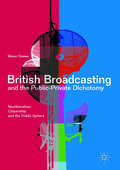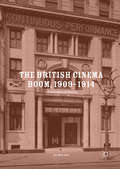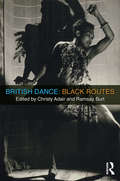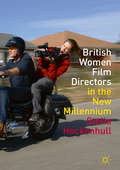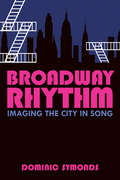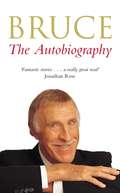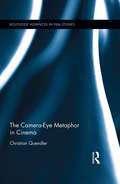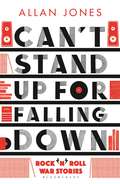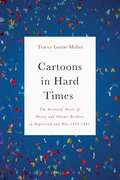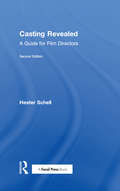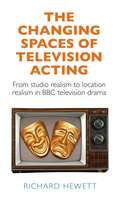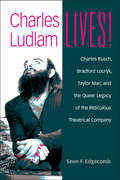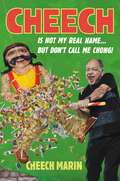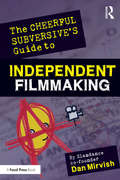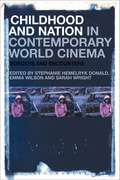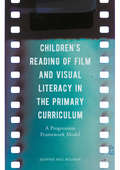- Table View
- List View
British Broadcasting and the Public-Private Dichotomy: Neoliberalism, Citizenship and the Public Sphere
by Simon DawesThis text offers a theoretical engagement with the ways in which private and public interests - and how those interests have been understood - have framed the changing rationale for broadcasting regulation, using the first century of UK broadcasting as a starting point. Unlike most books on broadcasting, this text adopts an explicitly Foucauldian and genealogical perspective in its account of media history and power, and unpicks how the meanings of terms such as 'public service' and 'public interest', as well as 'competition' and 'choice', have evolved over time. In considering the appropriation by broadcasting scholars of concepts such as neoliberalism, citizenship and the public sphere to a critical account of broadcasting history, the book assesses their appropriateness and efficacy by engaging with interdisciplinary debates on each concept. This work will be of particular significance to academics and students with an interest in media theory, history, policy and regulation, as well as those disposed to understanding as well as critiquing the neoliberalization of public media.
British Broadcasting and the Public-Private Dichotomy: Neoliberalism, Citizenship and the Public Sphere
by Simon DawesThis text offers a theoretical engagement with the ways in which private and public interests - and how those interests have been understood - have framed the changing rationale for broadcasting regulation, using the first century of UK broadcasting as a starting point. Unlike most books on broadcasting, this text adopts an explicitly Foucauldian and genealogical perspective in its account of media history and power, and unpicks how the meanings of terms such as 'public service' and 'public interest', as well as 'competition' and 'choice', have evolved over time. In considering the appropriation by broadcasting scholars of concepts such as neoliberalism, citizenship and the public sphere to a critical account of broadcasting history, the book assesses their appropriateness and efficacy by engaging with interdisciplinary debates on each concept. This work will be of particular significance to academics and students with an interest in media theory, history, policy and regulation, as well as those disposed to understanding as well as critiquing the neoliberalization of public media.
The British Cinema Boom, 1909–1914: A Commercial History
by Jon BurrowsThis book examines why thousands of cinemas opened in Britain in the space of a few years before the start of the First World War. It explains how they were the product of an investment boom which observers characterised as economically irrational and irresponsible. Burrows profiles the main groups of people who started cinema companies during this period, and those who bought shares in them, and considers whether the early cinema business might be seen as a bubble that burst. The book examines the impact of the Cinematograph Act 1909 upon the boom, and explains why British film production seemed to decline in inverse proportion to the mass expansion of the market for moving image entertainment. This account also takes a new look at the development of film distribution, the emergence of the feature film and the creation of the British Board of Film Censors. Making systematic and pioneering use of surviving business and local government records, this book will appeal to anyone interested in silent cinema, the history of film exhibition and the economics of popular culture.
British Dance: Black Routes
by Christy Adair Ramsay BurtBritish Dance, Black Routes is an outstanding collection of writings which re-reads the achievements of Black British dance artists, and places them within a broad historical, cultural and artistic context. Until now discussion of choreography by Black dance practitioners has been dominated by the work of African-American artists, facilitated by the civil rights movement. But the work produced by Black British artists has in part been within the context of Britain’s colonial legacy. Ramsay Burt and Christy Adair bring together an array of leading scholars and practitioners to review the singularity and distinctiveness of the work of British-based dancers who are Black and its relation to the specificity of Black British experiences. From sub-Saharan West African and Caribbean dance forms to jazz and hip-hop, British Dance, Black Routes looks afresh at over five decades of artistic production to provide an unparalleled resource for dance students and scholars.
British Dance: Black Routes
by Christy Adair Ramsay BurtBritish Dance, Black Routes is an outstanding collection of writings which re-reads the achievements of Black British dance artists, and places them within a broad historical, cultural and artistic context. Until now discussion of choreography by Black dance practitioners has been dominated by the work of African-American artists, facilitated by the civil rights movement. But the work produced by Black British artists has in part been within the context of Britain’s colonial legacy. Ramsay Burt and Christy Adair bring together an array of leading scholars and practitioners to review the singularity and distinctiveness of the work of British-based dancers who are Black and its relation to the specificity of Black British experiences. From sub-Saharan West African and Caribbean dance forms to jazz and hip-hop, British Dance, Black Routes looks afresh at over five decades of artistic production to provide an unparalleled resource for dance students and scholars. Appendix 2 of this book is freely available as a downloadable Open Access PDF at http://www.taylorfrancis.com under a Creative Commons Attribution-Non Commercial-No Derivatives (CC-BY-NC-ND) 4.0 license.
British Women Film Directors in the New Millennium
by Stella HockenhullThis book focuses on the output of women film directors in the period post Millennium when the number of female directors working within the film industry rose substantially. Despite the fact that nationally and internationally women film directors are underrepresented within the industry, there is a wealth of talent currently working in Britain. During the early part of the 2000s, the UKFC instigated policies and strategies for gender equality and since then the British Film Institute has continued to encourage diversity. British Women Directors in the New Millennium therefore examines the production, distribution and exhibition of female directors’ work in light of policy. The book is divided into two sections: part one includes a historical background of women directors working in the twentieth century before discussing the various diversity funding opportunities available since 2000. The second part of the book examines the innovation, creativity and resourcefulness of British female film directors, as well as the considerable variety of films that they produce, selecting specific examples for analysis in the process.
Broadway Rhythm: Imaging the City in Song
by Dominic SymondsBroadway Rhythm is a guide to Manhattan like nothing you've ever read. Author Dominic Symonds calls it a performance cartography, and argues that the city of New York maps its iconicity in the music of the Broadway songbook. A series of walking tours takes the reader through the landscape of Manhattan, clambering over rooftops, riding the subway, and flying over skyscrapers. Symonds argues that Broadway's songs can themselves be used as maps to better understand the city though identifiable patterns in the visual graphics of the score, the auditory experience of the music, and the embodied articulation of performance, recognizing in all of these patterns, corollaries inscribed in the terrain, geography, and architecture of the city. Through musicological analyses of works by Gershwin, Bernstein, Copland, Sondheim and others, the author proposes that performance cartography is a versatile methodology for urban theory, and establishes a methodological approach that uses the idea of the map in three ways: as an impetus, a metaphor, and a tool for exploring the city.
Bruce: The Autobiography
by Bruce ForsythBruce Forsyth is known across four generations as the face of family entertainment classics such as The Generation Game, Play Your Cards Right and The Price is Right. His is an amazing story that spans more than two thirds of the twentieth century. In the late 1950s, over half of Britain would tune in to Sunday Night at the London Palladium, making Bruce a star in a few weeks. But it had been a long slog since his debut as a fourteen-year-old 'Boy Bruce the Mighty Atom' in 1942, then wartime work for the Red Cross and National Service, and playing every theatre, concert party, summer season, double act and review known to man. Bruce's first-ever account of his whole life is chock full of anecdotes, honest appraisals of tough times, failed marriages and affairs, comments on entertainment and what it took to be a comedian at the height of his powers. 'In the gameshow of life, Brucie hasn't just won the TV, the golf clubs and the hostess trolley. He's won the cuddly toy as well' Mirror
The Camera-Eye Metaphor in Cinema (Routledge Advances in Film Studies)
by Christian QuendlerThis book explores the cultural, intellectual, and artistic fascination with camera-eye metaphors in film culture of the twentieth century. By studying the very metaphor that cinema lives by, it provides a rich and insightful map of our understanding of cinema and film styles and shows how cinema shapes our understanding of the arts and media. As current new media technologies are attempting to shift the identity of cinema and moving imagery, it is hard to overstate the importance of this metaphor for our understanding of the modalities of vision. In what guises does the "camera eye" continue to survive in media that is called new?
The Camera-Eye Metaphor in Cinema (Routledge Advances in Film Studies)
by Christian QuendlerThis book explores the cultural, intellectual, and artistic fascination with camera-eye metaphors in film culture of the twentieth century. By studying the very metaphor that cinema lives by, it provides a rich and insightful map of our understanding of cinema and film styles and shows how cinema shapes our understanding of the arts and media. As current new media technologies are attempting to shift the identity of cinema and moving imagery, it is hard to overstate the importance of this metaphor for our understanding of the modalities of vision. In what guises does the "camera eye" continue to survive in media that is called new?
Cannibal Holocaust (Devil's Advocates)
by Calum WaddellCannibal Holocaust is one of the most controversial horror films ever made. Despite not achieving huge success when it was first released, the Italian production found an audience on home video in the 1980s and became a 'must-see' for connoisseurs of extreme cinema. Indeed, Cannibal Holocaust's foremost legacy is in the United Kingdom, where it obtained its reputation as one of the most harrowing and offensive 'video nasties' – a term used to refer to a group of films deemed to be 'obscene' by the Department of Public Prosecutions. However, as the years have progressed, Cannibal Holocaust has been re-evaluated, mainly as the forefather of the 'found footage' film, and recent home video re-releases have added some valuable perspective to the onscreen violence with extensive cast and crew interviews. What is missing from this contemporary activity is contextualization of Cannibal Holocaust's style, affirmation and discussion of its locations and any extensive discourse about its representation of third world inhabitants (i.e. as 'primitives'). In addition, and also amiss from previous dialogue on the production, is that Cannibal Holocaust can be seen as one of the key post-Vietnam films. It is the spectre of war – and an explicit warning about Western involvement in civil conflict – which progresses Deodato's story of jungle adventurers in peril. By approaching the film from a more formalist position, this Devil's Advocate provides an insightful discussion of this groundbreaking film.
Can't Stand Up For Falling Down: Rock'n'Roll War Stories
by Allan JonesAllan Jones launched Uncut magazine in 1997 and for 15 years wrote a popular monthly column called Stop Me If You've Heard This One Before, based on his experiences as a music journalist in the 70s and 80s, a gilded time for the music press. By turns hilarious, cautionary, poignant and powerful, the Stop Me...stories collected here include encounters with some of rock's most iconic stars, including David Bowie, Lou Reed, Leonard Cohen, Van Morrison, Neil Young, Elvis Costello, The Sex Pistols, The Clash, The Smiths, R.E.M. and Pearl Jam. From backstage brawls and drug blow-outs, to riots, superstar punch-ups, hotel room confessionals and tour bus lunacy, these are stories from the madness of a music scene now long gone.
Cartoons in Hard Times: The Animated Shorts of Disney and Warner Brothers in Depression and War 1932-1945
by Tracey MolletCartoons in Hard Times provides a comprehensive analysis of the short subject animation released by the Walt Disney and Warner Brothers from 1932 and 1945, one of the most turbulent periods in Unites States history. Through a combination of content analysis, historical understanding and archival research, this book sheds new light on a hitherto unexplored area of animation, suggesting the ways in which Disney and Warner Brothers animation engaged with historical, social, economic and political changes in this era. The book also traces the development of animation into a medium fit for propaganda in 1941 and the changes in characters, tone, music and narrative that took place to facilitate this transition. Animation transformed in this era from a medium of entertainment, to a socio-political commentator before finally undertaking government sponsored propaganda during the Second World War.
Casting Revealed: A Guide for Film Directors
by Hester SchellCasting is an essential component of any film or video project, but the core skill-set needed to cast effectively is little understood. Casting Revealed: A Guide for Film Directors is a straightforward manual on the art and craft of casting. Here, director Hester Schell offers her insider perspective on casting workflows, industry standards, finding actors, running auditions, what to look for in a performance, contracts, and making offers. This new edition has been updated with fresh interviews with casting directors, full color head shots, new information about online video submissions, and a companion website featuring forms, contracts, and sample scenes for auditions. Gain a fuller understanding of the misunderstood art and craft of casting actors for film and video production. Learn to find the right actors for any production, run auditions, interview actors, effectively judge performances and video submissions, evaluate suitability for a role, discover what it is you need from an actor, view headshots, draft contracts, make offers, and navigate current industry standards, unions, and procedures. This new edition has been updated to include full color sample head shots, new content on online video submissions, listings of casting wesbites, film resources, and film commissions and a companion website featuring interviews with celebrated casting directors from New York, Portland, Boston and Austin, necessary forms, sign-in sheets, contracts, and sample scenes for auditions.
Casting Revealed: A Guide for Film Directors
by Hester SchellCasting is an essential component of any film or video project, but the core skill-set needed to cast effectively is little understood. Casting Revealed: A Guide for Film Directors is a straightforward manual on the art and craft of casting. Here, director Hester Schell offers her insider perspective on casting workflows, industry standards, finding actors, running auditions, what to look for in a performance, contracts, and making offers. This new edition has been updated with fresh interviews with casting directors, full color head shots, new information about online video submissions, and a companion website featuring forms, contracts, and sample scenes for auditions. Gain a fuller understanding of the misunderstood art and craft of casting actors for film and video production. Learn to find the right actors for any production, run auditions, interview actors, effectively judge performances and video submissions, evaluate suitability for a role, discover what it is you need from an actor, view headshots, draft contracts, make offers, and navigate current industry standards, unions, and procedures. This new edition has been updated to include full color sample head shots, new content on online video submissions, listings of casting wesbites, film resources, and film commissions and a companion website featuring interviews with celebrated casting directors from New York, Portland, Boston and Austin, necessary forms, sign-in sheets, contracts, and sample scenes for auditions.
The changing spaces of television acting: From studio realism to location realism in BBC television drama
by Richard HewettThis title is an historical overview and a then-and-now comparison of performing for British television drama. By examining changing acting styles from distinct eras of television production – studio realism and location realism - it makes a unique contribution to both television and performance studies, unpacking the various determinants that have combined to influence how performers work in the medium. Comparing the original versions of The Quatermass Experiment (BBC, 1953), Doctor Who (BBC, 1963–89) and Survivors (BBC, 1975–77) with their respective modern-day re-makes, the book unpacks the developments that have resulted from the shift from multi-camera studio to single camera location production. Textual analysis is combined with extensive archive research into production process and reception, alongside interviews with numerous actors and production personnel from more than sixty years of television production.
Charles Ludlam Lives!: Charles Busch, Bradford Louryk, Taylor Mac, and the Queer Legacy of the Ridiculous Theatrical Company (Triangulations: Lesbian/Gay/Queer Theater/Drama/Performance)
by Sean EdgecombPlaywright, actor and director Charles Ludlam (1943–1987) helped to galvanize the Ridiculous style of theater in New York City starting in the 1960s. Decades after his death, his place in the chronicle of American theater has remained constant, but his influence has changed. Although his Ridiculous Theatrical Company shut its doors, the Ludlamesque Ridiculous has continued to thrive and remain a groundbreaking genre, maintaining its relevance and potency by metamorphosing along with changes in the LGBTQ community. Author Sean F. Edgecomb focuses on the neo-Ridiculous artists Charles Busch, Bradford Louryk, and Taylor Mac to trace the connections between Ludlam’s legacy and their performances, using alternative queer models such as kinetic kinship, lateral historiography, and a new approach to camp. Charles Ludlam Lives! demonstrates that the queer legacy of Ludlam is one of distinct transformation—one where artists can reject faithful interpretations in order to move in new interpretive directions.
Cheech Is Not My Real Name: ...But Don't Call Me Chong
by Cheech MarinGet a look into the mind of Cheech Marin–one half of the renowned Cheech and Chong comedic duo–and follow through the highs and lows of his personal and professional lives. An unborn baby with a fatal heart defect . . . a skier submerged for an hour in a frozen Norwegian lake . . . a comatose brain surgery patient whom doctors have declared a "vegetable."The long-awaited memoir from a counterculture legend. Cheech Marin came of age at an interesting time in America and became a self-made counterculture legend with his other half, Tommy Chong. This insightful memoir delves into how Cheech dodged the draft, formed one of the most successful comedy duos of all time, became the face of the recreational drug movement with the film Up in Smoke, forged a successful solo career with roles in The Lion King and, more recently, Jane the Virgin, and became the owner of the most renowned collection of Chicano art in the world. Written in Cheech's uniquely hilarious voice, this memoir will take you to new highs.
The Cheerful Subversive's Guide to Independent Filmmaking: From Preproduction to Festivals and Distribution
by Dan MirvishIn The Cheerful Subversive’s Guide to Independent Filmmaking, celebrated Slamdance Film Festival co-founder Dan Mirvish offers a rich exploration of the process and culture of making low-budget, independent films. Once labelled a "cheerful subversive" by The New York Times, Mirvish shares his unfiltered pragmatic approach to scriptwriting, casting, directing, producing, managing a crew, post-production, navigating the film festival circuit, distributing your film, dealing with piracy and building a career. Readers will learn how to game the Hollywood system to their advantage, get their films accepted by respected festivals without going broke, and utilize a broad range of media and tactics to promote and distribute their work. A companion website features behind-the-scenes interviews and footage from Dan’s films, and much more. Learn everything you need to know to make, promote, and distribute your independent films, with time-tested lessons and practical advice on scriptwriting, casting and directing A-list actors, financing, producing, managing a crew, editing in post, creating visual effects on a budget, and successuflly navigating the film festival circuit Find out what it takes to become a true "cheerful subversive" and adopt new and innovative approaches to producing your films, discover hidden loopholes in the Hollywood system and festival scene, take advantage of a broad range of media formats to promote and distribute your indie films, and generally make bold moves in service of your creative work, all while staying flexible enough to pivot at a moment’s notice An extensive companion website features in-depth interviews with filmmakers, more than an hour of behind-the-scenes footage from Dan Mirvish’s films, festival resources, and much more
The Cheerful Subversive's Guide to Independent Filmmaking: From Preproduction to Festivals and Distribution
by Dan MirvishIn The Cheerful Subversive’s Guide to Independent Filmmaking, celebrated Slamdance Film Festival co-founder Dan Mirvish offers a rich exploration of the process and culture of making low-budget, independent films. Once labelled a "cheerful subversive" by The New York Times, Mirvish shares his unfiltered pragmatic approach to scriptwriting, casting, directing, producing, managing a crew, post-production, navigating the film festival circuit, distributing your film, dealing with piracy and building a career. Readers will learn how to game the Hollywood system to their advantage, get their films accepted by respected festivals without going broke, and utilize a broad range of media and tactics to promote and distribute their work. A companion website features behind-the-scenes interviews and footage from Dan’s films, and much more. Learn everything you need to know to make, promote, and distribute your independent films, with time-tested lessons and practical advice on scriptwriting, casting and directing A-list actors, financing, producing, managing a crew, editing in post, creating visual effects on a budget, and successuflly navigating the film festival circuit Find out what it takes to become a true "cheerful subversive" and adopt new and innovative approaches to producing your films, discover hidden loopholes in the Hollywood system and festival scene, take advantage of a broad range of media formats to promote and distribute your indie films, and generally make bold moves in service of your creative work, all while staying flexible enough to pivot at a moment’s notice An extensive companion website features in-depth interviews with filmmakers, more than an hour of behind-the-scenes footage from Dan Mirvish’s films, festival resources, and much more
Child Actors on the London Stage, Circa 1600: Their Education, Recruitment and Theatrical Success
by Julie AckroydA legal document dated 1600, for a Star Chamber case titled Clifton versus Robinson, details how boys were abducted from London streets and forcibly held in order to train them as actors for the Blackfriars theatre. No adults were seen on-stage in this theatre, which was stocked solely by acting boys, resulting in a satirical and scurrilous method of play presentation. Were the boys specifically targeted for skills they may have possessed which would have been applicable to this type of play presentation? And, was this method of recruitment typical or atypical of Elizabethan theatre? Analysis of the background of the boy subjects of the legal case indicate that several had received grammar-school tuition and, as a result, would have possessed skills in oration and rhetoric. Indeed, a significant number of the grammar schools in London provided regular public disputations and theatrical performances which would have made these boys an attractive proposition for inclusion in a theatrical company. The styles of play-texts which the boys performed and their manner of presenting characters helps to assess why child acting companies were commercially viable and popular. Their portrayal of all roles in a performance; young and old, male and female, clearly demonstrated their versatility and skill in mimicry and the adoption of other personas. Therefore the taking of grammar-school boys for re-training as actors was not opportunistic; their abductions were planned. The theatre owners undertook this method of recruitment as they felt that they were immune from prosecution due to holding royal commissions which they used to recruit boys. However, the Clifton vs. Robinson case clearly demonstrates that a determined parent whose child had been taken could challenge this and demand reparation.
Childhood and Nation in Contemporary World Cinema: Borders and Encounters
by Sarah Wright Emma Wilson Stephanie Hemelryk DonaldThe child has existed in cinema since the Lumière Brothers filmed their babies having messy meals in Lyons, but it is only quite recently that scholars have paid serious attention to her/his presence on screen. Scholarly discussion is now of the highest quality and of interest to anyone concerned not only with the extent to which adult cultural conversations invoke the figure of the child, but also to those interested in exploring how film cultures can shift questions of agency and experience in relation to subjectivity. Childhood and Nation in World Cinema recognizes that the range of films and scholarship is now sufficiently extensive to invoke the world cinema mantra of pluri-vocal and pluri-central attention and interpretation. At the same time, the importance of the child in figuring ideas of nationhood is an undiminished tic in adult cultural and social consciousness. Either the child on film provokes claims on the nation or the nation claims the child. Given the waning star of national film studies, and the widely held and serious concerns over the status of the nation as a meaningful cultural unit, the point here is not to assume some extraordinary pre-social geopolitical empathy of child and political entity. Rather, the present collection observes how and why and whether the cinematic child is indeed aligned to concepts of modern nationhood, to concerns of the State, and to geo-political organizational themes and precepts.
Childhood and Nation in Contemporary World Cinema: Borders and Encounters
by Sarah Wright Emma Wilson Stephanie Hemelryk DonaldThe child has existed in cinema since the Lumière Brothers filmed their babies having messy meals in Lyons, but it is only quite recently that scholars have paid serious attention to her/his presence on screen. Scholarly discussion is now of the highest quality and of interest to anyone concerned not only with the extent to which adult cultural conversations invoke the figure of the child, but also to those interested in exploring how film cultures can shift questions of agency and experience in relation to subjectivity. Childhood and Nation in World Cinema recognizes that the range of films and scholarship is now sufficiently extensive to invoke the world cinema mantra of pluri-vocal and pluri-central attention and interpretation. At the same time, the importance of the child in figuring ideas of nationhood is an undiminished tic in adult cultural and social consciousness. Either the child on film provokes claims on the nation or the nation claims the child. Given the waning star of national film studies, and the widely held and serious concerns over the status of the nation as a meaningful cultural unit, the point here is not to assume some extraordinary pre-social geopolitical empathy of child and political entity. Rather, the present collection observes how and why and whether the cinematic child is indeed aligned to concepts of modern nationhood, to concerns of the State, and to geo-political organizational themes and precepts.
Children's Reading of Film and Visual Literacy in the Primary Curriculum: A Progression Framework Model
by Jeannie Hill BulmanThis book draws on a longitudinal study which highlights the beneficial impact of film in the primary curriculum. It provides detailed accounts of both the reading process as understood within the field of literacy education, and of film theory as it relates to issues such as narration, genre and audience. The book focuses on a small cohort of children to explore how progression in reading film develops throughout a child’s time in Key Stage 2; it also examines how the skills and understanding required to read film can support the reading of print, and vice versa, in an ‘asset model’ approach. Since children’s progression in reading film is found to be not necessarily age-related, but rather built on a period of experience and opportunity to read and/or create moving image media, Bulman clearly illustrates the importance of the inclusion of film in the primary curriculum. The book provides an accessible study to a large audience of primary teachers and practitioners, and will be a valuable resource for students and researchers in the fields of education, English and media studies.
Children's Reading of Film and Visual Literacy in the Primary Curriculum: A Progression Framework Model
by Jeannie Hill BulmanThis book draws on a longitudinal study which highlights the beneficial impact of film in the primary curriculum. It provides detailed accounts of both the reading process as understood within the field of literacy education, and of film theory as it relates to issues such as narration, genre and audience. The book focuses on a small cohort of children to explore how progression in reading film develops throughout a child’s time in Key Stage 2; it also examines how the skills and understanding required to read film can support the reading of print, and vice versa, in an ‘asset model’ approach. Since children’s progression in reading film is found to be not necessarily age-related, but rather built on a period of experience and opportunity to read and/or create moving image media, Bulman clearly illustrates the importance of the inclusion of film in the primary curriculum. The book provides an accessible study to a large audience of primary teachers and practitioners, and will be a valuable resource for students and researchers in the fields of education, English and media studies.
